After Hair Transplant
- First Few Days After Hair Transplant
- 2 Weeks After Hair Transplant
- 4 Weeks After Hair Transplant
- 3 Months After Hair Transplant
- 6 Months After Hair Transplant
- 1 Year After Hair Transplant
- After The First Year of Hair Transplant
FIRST FEW DAYS AFTER HAIR TRANSPLANT
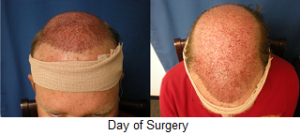
The first 4 days after a hair transplant are the most critical as hair transplant patients need to be extra careful about washing their hair, especially the transplanted areas. There is a special “hair washing” appointment the day after the procedure designated to show you how to properly wash, with critical care of the transplanted areas. Special shampoo and sponge will be provided as well. After 4 days most people can return to a normal hair washing routine.
Returning to Work after Hair Transplant
You can return to work as early as the day after your hair restoration procedure, but if your job requires any kind of lifting, bending, stretching, physical strain or touching chemicals, patients can take a few days off until the acute phase is over. Some patients may want to take days off only because they want to keep their hair transplant procedure confidential. In cases like this patients can take 1 to 2 weeks off from work. The most critical time for patients after the hair transplant procedure are the first four days, as they must be extra careful to avoid any type of strain, after four days the transplanted grafts are usually well settled.
Physical Activities after Hair Transplant
No physical activity that can cause strain on the back of head, sutured, or stapled area should be done. There are no limitations for mild exercises as long as the patient does not bend his/her head aggressively or touch the transplanted area. Contact sports should be avoided for the first month in most patients who had a transplant surgery.
Possible Complications
Pain and Discomfort: There may be some aching in the donor area, which starts within the first few hours after hair transplantation. Pain medicine is generally provided to alleviate the discomfort during the first night. After the first night, pain should be well controlled. Most patients do not need any medications for pain after the first night, but if there is any remaining pain during the second day, mild pain medications such as Tylenol, in most cases, should be enough to make you feel more comfortable.
Swelling: It is common for the first four days after a hair restoration procedure for swelling to occur around the transplanted area. Swelling is due to the process of healing and may range from non-existent to severe in which the subcutaneous fluid descends from the forehead area to around the eyes. The maximum swelling is generally seen in days 3 and 4 after hair transplantation. Patients may need steroids to prevent swelling after their hair restoration. It is good to sleep in a semi-sitting position and keep the upper body elevated to help minimize the swelling, or shorten its duration.
Bruising: Bruising or discoloration of skin around the transplanted area might be present for the first few days after the hair restoration procedure. This may involve the recipient area, and at times, may extend to the forehead. We usually give a baseball cap to our patients in order to help cover the transplanted area, but those with existing hair can use their own hair to cover the bruised areas of the transplanted sites.
Scabbing: Scabs should flake off within one week if the patient properly washes the transplanted areas. We recommend washing transplanted areas, the way we show it, twice a day for the first 4 days. Patients can go back to their routine hair wash after that time unless they continue to have scabbing. Those who have scabbing will need to continue washing their head twice a day, until the scabbing goes away.
Itching: Itching is a common symptom after any type of wound healing. Hair transplantation is not an exception to that reality. Patients may feel itching on transplanted and donor areas for the first few days. This may extend to the second week after hair transplant, but should be mild and does not require any treatment for most patients. If itching is significant, a prescription of a mild steroid cream might help.
2 WEEKS AFTER HAIR TRANSPLANT
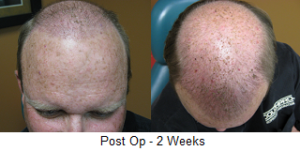
Physical Activity
It’s okay to resume exercise two days after hair transplant. It is critical to be selective about the types of exercises which can be done (such as not doing squats, bent rows, lifts, etc.) for the first four days after surgery. Always aim to keep your head elevated/upright. Bending the head may increase the tension of the donor area which may increase the chance of stretching the scar.
Possible Complication
Redness and Inflammation: The inflammation and redness should be subsided at this time, but a mild pinkish discoloration of the transplanted area may remain. This can be visible for a few weeks comparable to a sun burn, especially in patients with lighter skin.
4 WEEKS AFTER HAIR TRANSPLANT
Hair Growth
Transplanted hair grafts should have set in their new location on the scalp and the hairs attached should have fallen out. After being replanted, the stubby hair falls out and the new strands of hair begin to grow after a couple of months.
Physical Activity
Patients should be able to resume most physical activities they used to do before hair transplantation. The key is avoiding strain on the scar area if a strip, or FUT, hair transplant was performed. If an FUE procedure was performed, then more intense exercises are permitted.
Possible Complication
Redness and Inflammation: The inflammation should be subsided by this point in most patients. Transplanted hair generally falls out in the first two to three weeks and patients go back to where they were before hair transplantation at this point.
3 MONTHS AFTER HAIR TRANSPLANT
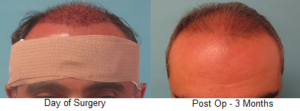
Appearance
Patient’s appearance should be the same as before having the hair transplant. Patients generally don’t keep the newly transplanted hair, and commonly lose the shaft of hairs while the follicles become part of the scalp and generate new hairs.
New Growth
Patients who have complete baldness (no visible hair before hair transplant), should be able to see some very small hair in the transplanted area. Folliculitis or pimple shaped lesions may be noted in some patients at this time. They generally form because of the collection of sebum (oily secretions of the hair follicles). Folliculitis lesions usually drain spontaneously without any need for any interventions. If folliculitis lesions are more than two or they are painful, you need to see your surgeon to have those lesions drained for you. Drainage of folliculitis is generally simple and painless.
Possible Complication
Shock Loss: This may occur for some patients after their hair transplantation . Patients may lose some of their native hair due to shock loss after their hair transplant. This happens while they still do not see the bulk of the transplanted hair grown in yet. Some patients may feel the bulk of their hair is lessening more than what it was before the hair transplant. This does happen at times until the next few months after hair transplant when the patients can see the newly transplanted hair along with regrowth from some of the hair that has gone through shock loss.
6 MONTHS AFTER HAIR TRANSPLANT
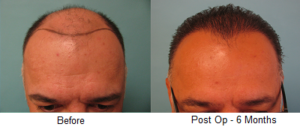
Hair Growth
Six month appointments are recommended to all patients after a hair transplant in order to be seen for an early evaluation of their growth. This is a very exciting time for patients, as they may begin to see first signs of growth for the transplanted hair. Although, some patients will begin to see their full results at six months, most patients will continue to see further improvement after month 6.
Postoperative six-month visit is important for some patients because it may determine if they need to consider another hair transplant. Patients who wish to achieve very high density of hair along their hairline or other areas may need a second procedure in order to double up the density of hair to those areas. We generally cannot implant more hair until 6 months past a previously transplanted area for three reasons:
- We don’t have a solid understanding of the final growth before this time.
- Some of the transplanted hair has not grown before the six-month mark so there is a risk that we may transplant grafts on top of previously transplanted area.
- The donor scar is not quite mature and the laxity of the scalp might not be completely back to the normal.
1 YEAR AFTER HAIR TRANSPLANT
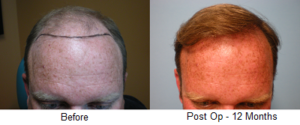
Hair Growth
More fullness should be expected at this point through 18 months from the hair transplant. This case is especially true for the patients who grow their hair long. Many patients at this time can see their final result and determine whether a second hair restoration procedure is necessary or not.
It is crucial to stay in touch with your hair transplant surgeon during the entire time after your hair transplantation, if you have any concerns or questions. We at US Hair Restoration want to see our patients after their hair transplantation for 4 standard follow up visits.
Follow up Visits
The follow up visits are:
Day 1: immediate post op evaluation and giving patient his/her first hair wash.
Week 2: second week evaluation, removing the sutures or staples in strip patients and reviewing further care they need in the next few months.
Month 6: evaluation of early growth.
Month 12: full result.
We encourage our patients to contact us for any concerns at any time between their routine follow ups or after their final 12 months follow up. One of the keys to the success of a hair transplant procedure is close communication with the patients and the hair restoration staff during the post operational period.